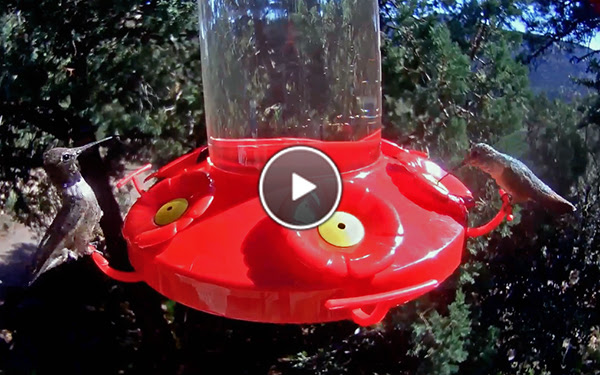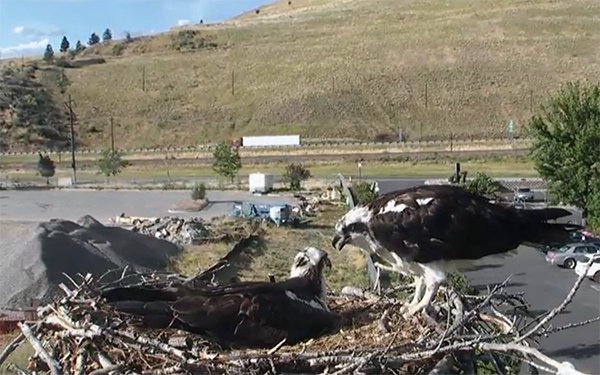 |
| Black-Chinned Hummingbirds stop for a drink at the Perky-Pet® feeder. |
|
All Hummingbirds, All the Time
We’re excited to bring you a second action-packed season of the West Texas Hummingbird Feeder Cam, sponsored by Perky-Pet®. This site is nestled in the mountains outside Fort Davis, Texas, at an elevation of over 6,200 feet. During peak hummingbird migration, this site hosts 24 Perky-Pet® Grand Master hummingbird feeders, attracting hundreds of hummingbirds from a dozen species that are migrating through the arid mountains.
For the past 10 years, researchers from West Texas Avian Research have been banding hummingbirds at this site and others throughout the Trans-Pecos region of Texas to study the status and distribution of hummingbirds throughout the poorly known region. Last year we started broadcasting during the height of the fall migration in September (check out the highlights); this year, you’ll get the opportunity to watch the diversity and abundance of these agile fliers grow throughout the summer, and get to know them one-by-one. Right now, the most common species on cam are Broad-tailed Hummingbirds, along with Black-throated, Magnificent, and soon, Rufous hummingbirds.
You may also hear or glimpse other common species of the arid mountain forests, including Western Scrub-Jays, Acorn Woodpeckers, and Canyon Wrens. From time to time you may hear researchers working in the background as they band hummingbirds nearby.
Thanks to West Texas Avian Research for their enthusiasm and support for hosting the camera at this remote research site, and to cam sponsor Perky-Pet®. Watch the cam now. |
|
 |
| Iris approaches Louis to switch incubation duties. |
|
Bird Cams Season Round-Up: Successes and Challenges
Each year, we’re excited to share the beauty and discovery that accompanies a new season of nesting and raising the next generation of birds. The season’s round-up shows the spectrum of successes and challenges that birds experience.
- In April, two owlets fledged from the Great Horned Owl cam hosted by Skidaway Audubon in Savannah, Georgia. Since then, an Osprey pair has been spending time at the nest site throughout the summer.
- The Barred Owls featured on our Wild Birds Unlimited cam fledged three young in May.
- On the Cornell hawks cam, Big Red and Ezra fledged three young for the fifth year in a row. Unfortunately, in the weeks after fledging, G1 and G3 were found injured after apparently colliding into windows or buildings. Both received care from the Janet L. Swanson Wildlife Health Center at Cornell. G1 is healing well and is in the care of a rehabilitator. We are sad to report that G3 had to be euthanized after veterinarians found that it would not be able to recover from its severe injury.
- Record-breaking rainfall and flash flooding made it difficult for the Texas Barn Owls to find enough food for their six young. Dash, the male, disappeared, four owlets starved, and one owlet was taken and presumably killed by an unknown Barn Owl. The Cornell Lab asked a rehabilitator to take in the last remaining owlet after the female, Dottie, disappeared from the nest for more than two days. Pearl the owlet is doing well at the Rogers Wildlife Rehabilitation Center. Dottie has since returned to the nest and has paired with another male.
- On our longstanding Hellgate Osprey cam with the Montana Osprey Project, Stanley did not return to the nest to breed this year, leaving Iris to breed with a new male named Louis. Unfortunately, all of the eggs were either damaged, predated, or failed to hatch.
- The young Laysan Albatrosses, Honua, Hala, and Keiki, fledged, and another three are due to fledge soon. See the next news item for details.
Many viewers have told us that it was difficult to witnessing the reality of mortality and nest failures of wild birds while at the same time it inspired them to appreciate the tenacity and motivation that birds require to breed successfully. We will continue to learn from both the beautiful and the challenging phenomena that these 24/7 cams show in the lives of birds. Thanks for watching with us and sharing your observations, and thank you for your many expressions of support during a challenging season. |
|
 |
| Hala pauses to ponder the deep blue ocean before launching into the air.
Image © Hob Osterlund
|
|
Young Albatrosses Take to the Skies
Sometime between the evening of June 25 and and early morning on the 26th, the first young Laysan Albatross fledged (off-camera) from our Albatross Cam site on Kauai! Honua was last seen around 6:25 PM Saturday practicing flapping out in the big field, and when Kauai Albatross Network volunteers arrived the following morning, s/he had departed for the open ocean. Amazingly, the next time Honua sets foot on land will be 3-4 years from now! Those years are spent foraging across the ocean and learning the ropes of how to be an albatross. Since that time, two other albatrosses (Hala and Keiki) have also fledged, leaving three young birds still on site.
Researchers have attached geolocators to some of the young albatrosses on Kauai from past years, and we’re awaiting the hopeful return of our first star of the Albatross Cam (Kaloakulua) in the next year or two so we can learn more about where she has been.
As the season winds to a close, you can also take the opportunity to learn more about albatrosses through the experiences and observations of the Kauai Albatross Network’s founder Hob Osterlund, in her new book “Holy Mōli: Albatross and Other Ancestors.” It’s available on Amazon or you can order directly for a signed copy.
There are still another 3 young albatrosses that will fledge from the albatross cam site—tune in and catch their last days of flight practice before they, too, take wing! Special thanks to our on-island collaborators at the Kauai Albatross Network, to the property owners for encouraging and supporting the cam, and to the volunteers who have helped everyone enjoy and learn from the birds this season. Watch cam. |
|
|
|

